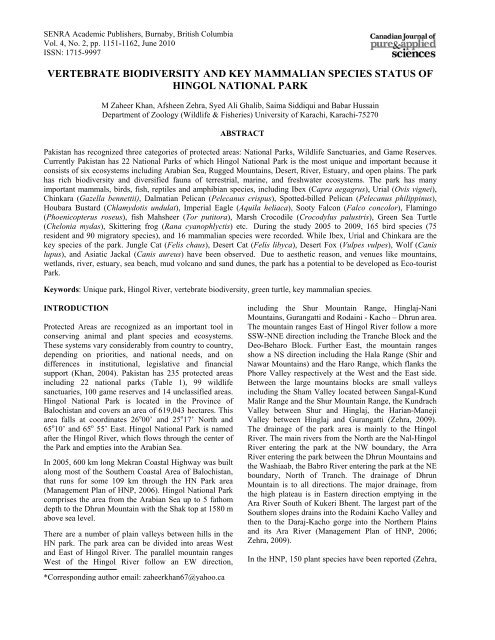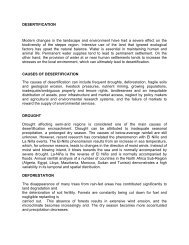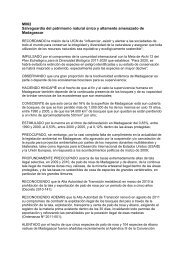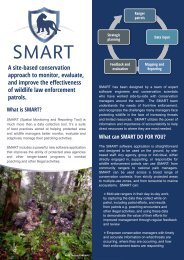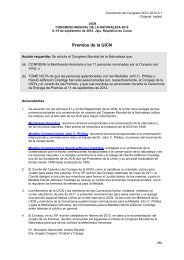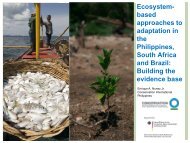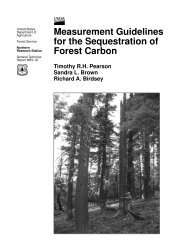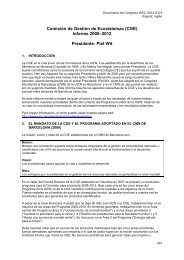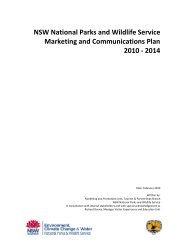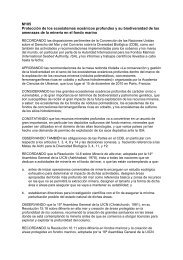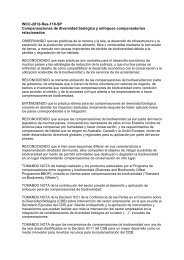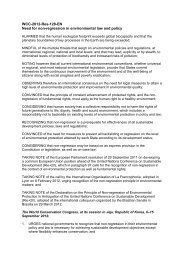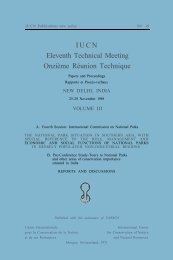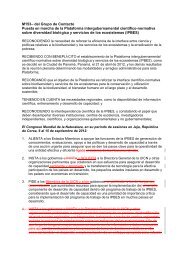VERTEBRATE BIODIVERSITY AND KEY MAMMALIAN SPECIES STATUS OF HINGOL ...
VERTEBRATE BIODIVERSITY AND KEY MAMMALIAN SPECIES STATUS OF HINGOL ...
VERTEBRATE BIODIVERSITY AND KEY MAMMALIAN SPECIES STATUS OF HINGOL ...
You also want an ePaper? Increase the reach of your titles
YUMPU automatically turns print PDFs into web optimized ePapers that Google loves.
1152Canadian Journal of Pure and Applied SciencesTable 1. Current List of the National Parks of Pakistan (Khan and Siddiqui, 2005; Ahmad, 2009).Name of NationalYear of Name ofYear ofLocationLocationParkestablishment National ParkestablishmentAyubia NWFP 1984 Kala Chitta Punjab 2009Central Karakoram Northern Areas 1995 Khirthar Sindh 1974Chinji Punjab 1987 Khunjerab Northern Areas 1975Chitral Gol NWFP 1984 Lal Suhanra Punjab 1972Deosai Northern Areas 1993 Lulusar NWFP 2003Deva Vatala AJK 2009 Machiara AJK 1996Ghamot AJK 2004 Margalla Hills Fed. Capital Territory 1980Gurez AJK 2009 Pir Lasora AJK 2005Handrap Shandoor Northern Areas 1993 Saif-ul-muluk NWFP 2003Hazarganji Chiltan Balochistan 1980 Sheikh Budin NWFP 1993Hingol Balochistan 1997 Toh Pir AJK 20052009). The main vegetated areas are in the small zones ofthe valleys, the floodplains, riverbeds, and more extensivearea of the coastal plains. Most ecological units are bareor almost bare including the mud flats, the salt plains, theclay Mountains and mud vent areas, the stone rippledterraces, and the smooth slopes of brown clay rock,mountains ridges, the steep mountain walls and thecrusted valley floor and the active flood bank areas. Thepark is represented by six ecosystems including ArabianSea, Rugged Mountains, River, Desert, Estuary, and openplains. The wildlife of the coastal area of HNP is diversedue to a combination of habitats found together at severalareas. The coastal plains show rocky hill areas (SappatMountains, Agor Hills, Jabal Haro-Kund Malir), sanddunes, agricultural fields and river beds.The Arabian Sea, including the area bordering nationalpark, is known to be highly productive. Nesting of Greenturtle has been reported from the coastal area of HNP. Avariety of water birds occurs at the coast line. Estuarinearea of the River Hingol, supports a variety of residentand migratory water birds. Adjacent to coastline there is alarge desert with prominent sand dunes. These sand dunesmay be categorized as stable or fixed sand dunes. Thedesert area of the park has diversified biodiversityincluding birds, small mammals and reptiles. Occurrenceof Houbara Bustard in winter is also reported in the duneareas (Azam, 2004).The objective of the present study was to record thevertebrate biodiversity and population status of three keymammalian species (Ibex, Urial and Chinkara) of HingolNational Park in the selected areas during 2005-2009.MATERIALS <strong>AND</strong> METHODSBased on preliminary studies in the Hingol National Park,Nani Mandir Complex, Rodaini Kacho, Harian Valley,Dhrun, Machii, Maneji, Ara Kaur, Babro Kaur , Agor,Kundrach, Qasim Goth, Wadh Bundar, Maneji, NaniMandir/Nani Bent, Nala Jhakee, Kashee Goth, KundMalir, Kalair Goth, Nokoo Goth, Allah Buksh Goth, andSanguri area were selected for the study of keymammalian and other vertebrate biodiversity (Table 2,Fig. 1, 2). The following methods and surveys techniqueswere employed for the observation, census anddocumentation of key mammalian species.1. Track Counts2. Point Surveys3. Roadside Counts4. Line Transects or Strip Census5. Pellet CountsTrack CountsTracks can be the first indication of the presence ofanimals in an area. Track counts especially after rain areuseful in identifying different animals especially fornocturnal and secretive ones. A fresh rain eliminates theprevious tracks, and the recent tracks of animals enteringor leaving the study areas can be used as a measure oftheir abundance. During all studies the track counttechnique was applied at selected areas of HNP and thiswas more effective compare to other methods.Point SurveysIn this method, observation points are established alongroads, edges of ponds or marshes, at a higher place andother locations suitable for viewing the habitat. For aperiod of 1 to 5 hours at each observation point, theobserver records all sightings of the mammals at that siteand then an index of abundance of each species isexpressed as the number of animals seen per hour ofobservations (Brower et al., 1990). Point surveys wereconducted twice daily, first during early morning, i.e. onehour before sunrise until dawn and second, in the evening,i.e., begins one-half an hour before the sunset until dark.Roadside CountsUsually it is difficult to locate a mammal especially alarge mammal by walking in its habitat, because it smells
Khan et al. 1153Fig. 1. Study areas of key mammalian species and birds of Hingol National Park.Fig. 2. Study areas of small mammals and birds of Hingol National Park.human presence from a long distance. Hence, the methodof roadside counts was applied to locate and estimate thepopulation of different mammalian species. In thismethod, the observer travels by motor vehicle along roadsand trails while the sighted number of individuals of thespecies being estimated is tallied and related to thenumber of km travelled (Brower et al., 1990). Thismethod has some advantages such as; travelling by
1154Canadian Journal of Pure and Applied Sciencesvehicle disturbs the animals and there is always a chanceto observe the animals along the road / track from adistance of few meters. Secondly, by this method largeareas can be covered quickly and easily by only twopersons. The roadside counts technique was appliedduring survey along the coastal highway, mostly fornocturnal mammals like foxes, jackals, cats as well as forthe diurnal mammals e.g., mongoose. For this purpose,4 x 4 vehicles were driven at a slow speed (7km/h) oninter-compartmental tracks, sandy plains river bank(4km/h) and on rough tracks along water channels atHingol River (3km/h) in the park. These roadside countswere carried out during early morning, at dusk and duringnight by using search lights on top of the vehicle.Line TransectsThe line transect or strip census method of populationestimation involves counting the animals seen by anobserver traversing a predetermined transect line andrecording the distances at which they were seen orflushed. The average of the flushing distance isdetermined and used to calculate the effective width ofthe strip covered by the observer. The population for theentire area is then considered to be the number ofanimals flushed, divided by the area of the strip andmultiplied by the total area (Schemnitz, 1980).P = AZ / 2 XYWhere P = populationA = total area of studyZ =number of animals flushedY =average flushing distanceX =length of stripLine transects or strip census method is particularly auseful technique when animals are difficult to see andmust be flushed to be counted. This methodology wasapplied in HNP for estimating large mammals eg., Ibex,Urial, Chinkara etc. The transect method was also usedfor surveys of marine mammals in HNP. The transect wasrandomly selected from the chart prior to leaving shore.Large and medium sized boats were used during thesurvey. The boat speed was maintained below 12 knotsand the width of transect was 25 m on either side of theboat. Two observers and one recorder worked at a time.Each observer watched 90 0 in an arc sweeping one quarteron front view from mid boat. The auto focus binocularswere used for observations.Pellet CountsFecal material such as pellets counted in a specific area isa good technique for locating large mammals andassessing their population. This technique involvesremoving all pellet groups from plots and then estimatingfrom subsequent observations on those plots the numberof groups per hectare to compare animal use of areasbetween sampling periods. In some cases it is notpossible to remove all the pellet groups from an area.Therefore, under such circumstances; an observer with alittle practice can identify the fresh pellets depending onthe color and dryness of the pellets. Ten to fifteen 100 sq.m plots (7.07 X 14.14) can be used for this purpose.These plots should be checked every three to seven daysand the periods between sampling should not be solong that feces will decompose or be destroyed byweather or insects. A random selection of plots in thestudy area and the number of pellets groups in each plotwere tallied and summed (Brower et al., 1990).The number of pellet group per unit area is determined asan index of density (ID) and determined as:ID = n / Awhere, n is the sum of pellet group counted over all plotsand A is the total area sampled (i.e., the sum of the areasof all the plots).This method is effective in habitats with dry weather andlittle or no dung beetle activity where pellets groupsremain preserved between sampling periods. Aftercounting pellets, one must be assured that they will not becounted on successive sampling periods so they should beremoved by the observer if they will not disappear bynatural processes. Defecation rates for the species underthe study are estimated if it is desired to convert pelletcounts to number of animals.Techniques and tools for survey of small mammalsTrappingSherman Traps were used to collect the live specimens.Traps were set on a line approx 500 m long and approx 10m apart. Each trap was marked by a colored ribbon tolocate the traps easily. The traps were set in theafternoon and checked early morning. The trappedanimals were each carefully transferred into an alreadyweighed transparent polythene bag. The species and sexof the trapped animals were noted. Other data for eachtrap, such as date of trap setting, date of data collection,habitat, location, elevation and weather conditions wererecorded on a data sheet. After recording the data, theanimals were released. Specimens with some doubt inidentification were preserved in 10% formalin andbrought to laboratory and identified. Specimens ofeach species were preserved as voucher specimens.A mixture of different food grains mixed with fragrantseeds was used as bait to attract small mammals. Wheatand rice were used as food grains while peanutbutter coriander, oats and honey were used forfragrance. This bait was very successful in the study areaprobably due to overall food shortage and also becausefour ingredients were used for fragrance. Freshly prepared
Khan et al. 1155bait was used on every trapping day. Only a small amountof bait was put on the platform near the traps. Because oflimited time for surveys, trapping was done only at nightat each of the sites and for best results trapping continuedat least for 3 nights. To supplement low intensity trappingduring field surveys, other data collection procedures suchas active searching (day and night), spot light search, andinterviews of local peoples, visible signs and literaturereview were also adopted.Spot Light MethodThis method is used at night for locating small and largemammals such as Hare, Porcupine, Hedgehog, Fox, WildCat, Jackal etc. because all these nocturnal animals movefor food. In this way the populations of different speciesat different localities were estimated.Counting of Fresh Holes and TracksAccording to Brower et al. (1990) the holes and tracksmethod can be used to determine the population range andstatus of small mammals. Fresh holes and tracks werecounted in the study area of one sq. km, which providedpopulation estimate.Several bird surveys were undertaken during the study.For bird identification, field guides such as Grimmett etal. (1988) and Khanum et al. (1980) were used.RESULTS <strong>AND</strong> DISCUSSIONIn this study, vertebrate biodiversity and key mammalianspecies status of Hingol National Park was determined forthe selected sites, using several methods and surveytechniques for the observation, census and documentationof the mammalian fauna, and other vertebrate biodiversityfrom 2005 to 2009. During the study, 16 mammalianspecies have been recorded including three large and 13small mammal speciesPopulation and Status of Key Mammalian SpeciesThree key mammalian species have been recorded during2005 to 2007. Ibex (Capra aegagrus) was rated common,while Urial (Ovis vignei), and Chinkara (Gazellabennettii) less common. In 2005, Ibex was rated 79.64%,Urial 10.32%, and Chinkara 10.02% (Table 3). In 2006,Ibex was rated 78.53%, Urial 11.12%, and Chinkara10.34% (Table 4). In 2007, Ibex was rated 78.29%, Urial11.18%, and Chinkara 10.51% (Table 5). During 2008and 2009, Wild goat (Capra aegagrus) was rated ascommon, while Urial (Ovis vignei), and Chinkara(Gazella bennettii) less common. In 2008, Wild goat wasrated 79.16%, Urial 11.45 %, and Chinkara 9.37% (Table6). In 2009, Wild goat was rated 80%, Urial as 11.6%,and Chinkara 8.4% (Table 7). The population of keyspecies at Nani Mandir Complex, Rodaini Kacho, HarianValley, Dhrun, Machii, Maneji, Ara Kaur, and BabroKaur areas has also been summarized in tables 8-10.Ibex (Capra aegagrus)There are three key mammalian species in HNP, andCapra aegagrus (Ibex) is one of them. The estimatedpopulation of Ibex was observed was 540 in 2005, 600 in2006, 700 in 2007, 760 in 2008 and 800 in 2009 indifferent areas of the park (Table 8). Males, females,yearlings and young ones were also included in count.During the study period 2005 – 2009, the habitatconditions are better as both feed and shelter are in plentyin HNP. Even though the Ibex has to face the huntingpressure from different sources and disturbance atdifferent times of the year from the pilgrims to NaniMandir area and from the livestock herders, its populationis still good. Livestock pressure in the area is the decidingfactor in the distribution of the Ibex. In the face ofcompetition with the livestock, Ibex either leave the areaor their visitation is reduced.Urial (Ovis vignei)During the study period, Ovis vignei (Urial) was rated asless common. The estimated population of Urial wasobserved was 70 in 2005, 85 in 2006, 100 in 2007, 110in 2008 and 116 in 2009 in different areas of the park(Table 9). The Urial population has faced the huntingpressure due to easy access to its habitat and thecompetition with the livestock. However, during ourstudy, no direct evidence of hunting pressure on Urial wasfound. The reason for the decline could be thedeterioration in habitat conditions and competition withlivestock. (Scanty population demands further studies andadoption of conservation measures). Urial habitat wasobserved in the foothill areas, close to the mountainswhere a reasonably good shelter may be available.Chinkara (Gazella bennettii)Gazella bennettii (Chinkara) was also rated as lesscommon. Chinkara being distributed in the plain area issusceptible to hunting pressure as these areas are easilyapproachable even on motor cycles. This was evident bythe presence of signs of motor cycles in many areas. Thecondition of the animals seen was good and did notsuggest that they were not reproducing. The habitatconditions in the area were suitable. There was noindication of a competition with the livestock as nointeraction was witnessed. Chinkara was observed inspecific habitat viz., large plain areas in the valleybottoms and vast nullah beds. They move to themountains or even to the foothill. Low population ofChinkara needs immediate attention and further studiesespecially into the population structure and nonrecruitmentto the population are required. The estimatedpopulation of Chinkara was observed to be 68 in 2005, 79in 2006, 94 in 2007, 90 in 2008 and 84 in 2009 indifferent areas of the park (Table 10).
1156Canadian Journal of Pure and Applied SciencesTable 3. Population of key Mammalian Species of Hingol National Park in 2005.S.IbexUrial ChinkaraStudy AreaNo(Capra aegagrus) (Ovis vignei) (Gazella bennettii)Total %1. NaniMandir Complex 325 - - 325 47.932. Rodaini Kacho 110 11 10 131 19.323. Harian Valley 40 09 13 62 9.144. Dhrun 18 - - 18 2.655. Machii 25 14 - 39 5.756. Maneji 22 15 12 49 7.227. Ara Kaur - 11 17 28 4.128. Babro Kaur - 10 16 26 3.83Total 540 70 68 678% 79.64 10.32 10.02Table 4. Population of key Mammalian Species of Hingol National Park in 2006.S.IbexUrial ChinkaraStudy AreaNo(Capra aegagrus) (Ovis vignei) (Gazella bennettii)Total %1. NaniMandir Complex 360 - - 360 47.122. Rodaini Kacho 120 13 12 145 18.973. Harian Valley 44 10 16 70 9.164. Dhrun 20 - - 20 2.615. Machii 30 17 - 47 6.156. Maneji 26 18 12 56 7.327. Ara Kaur - 15 21 36 4.718. Babro Kaur - 12 18 30 3.92Total 600 85 79 764% 78.53 11.12 10.34Table 5. Population of key Mammalian Species of Hingol National Park in 2007.S.IbexUrial ChinkaraStudy AreaNo(Capra aegagrus) (Ovis vignei) (Gazella bennettii)Total %1. NaniMandir Complex 415 - - 415 46.422. Rodaini Kacho 140 14 15 169 18.903. Harian Valley 50 12 20 82 9.174. Dhrun 29 - - 29 3.245. Machii 36 20 - 56 6.266. Maneji 30 20 16 66 7.387. Ara Kaur - 18 22 40 4.478. Babro Kaur - 16 21 37 4.13Total 700 100 94 894% 78.29 11.18 10.51Population and Status of Small MammalsFrom 2005 – 2009, thirteen species of small mammalshave been recorded. Based on the data, House Mouse(Mus musculus), Balochistan Gerbil (Gerbillus nanus),Palm Squirrel (Funambulus pennantii), Afghan Hedgehog(Hemiechinus auritus), House Rat (Rattus rattus),Porcupine (Hystrix cristatus), Indian Gerbil (Tateraindica), and Grey Spiny Mouse (Mus saxicola) were ratedas common, while Cairo Spiny Mouse (Acomyscahirinus), Cape Hare (Lepus capensis), Mouse likeHamster (Callomyscus bailwardi), and Indian Desert Jird(Meriones hurrianae) were rated as less common, andduring 2006 – 2009, Persian Jird (Meriones persicus) wasrated as rare.In 2005, House Mouse was rated as 12.17%, BalochistanGerbil 8.86%, Cairo Spiny Mouse 5.79%, Palm Squirrel11.34%, Cape Hare 3.54%, Mouse like Hamster 4.49%,
Table 6. Population of key Mammalian species of Hingol National Park in 2008.Khan et al. 1157S.IbexUrialChinkaraStudy AreaNo(Capra aegagrus) (Ovis vignei) (Gazella bennettii)Total %1. Nani Mandir Complex 445 - - 445 46.352. Rodaini Kacho 148 16 14 178 18.543. Harian Valley 56 14 19 89 9.274. Dhrun 34 - - 34 3.545. Machii 42 22 - 64 6.666. Maneji 35 22 16 73 7.607. Ara Kaur - 19 21 40 4.168. Babro Kaur - 17 20 37 3.85Total 760 110 90 960% 79.16 11.45 9.37Table 7. Population of key Mammalian Species of Hingol National Park in 2009.S.IbexUrialChinkaraStudy AreaNo(Capra aegagrus) (Ovis vignei) (Gazella bennettii)Total %1. NaniMandir Complex 467 - - 467 46.72. Rodaini Kacho 155 17 13 185 18.53. Harian Valley 59 15 18 92 9.24. Dhrun 38 - - 38 3.85. Machii 44 23 - 67 6.76. Maneji 37 23 15 75 7.57. Ara Kaur - 20 20 40 48. Babro Kaur - 18 18 36 3.6Total 800 116 84 1000% 80 11.6 8.4Table 8. Population of Ibex (Capra aegagrus) in HNP during 2005 to 2009.S. No. Study Area 2005 2006 2007 2008 20091. Nani Mandir Complex 325 360 415 445 4672. Rodaini Kacho 110 120 140 148 1553. Harian Valley 40 44 50 56 594. Dhrun 18 20 29 34 385. Machii 25 30 36 42 446. Maneji 22 26 30 35 37Total 540 600 700 760 800Afghan Hedgehog 10.87%, House Rat 9.69%, IndianDesert Jird 6.38%, Porcupine 10.52%, Indian Gerbil9.10%, and Grey Spiny Mouse 7.21%.In 2006, House Mouse was rated as 11.12%, BalochistanGerbil 10.01%, Cairo Spiny Mouse 6.06%, Palm Squirrel11.12%, Cape Hare 5.35%, Mouse like Hamster 4.55%,Afghan Hedgehog 11.12%, House Rat 8.08%, IndianDesert Jird 4.85%, Porcupine 9.90%, Indian Gerbil8.80%, Grey Spiny Mouse 7.88%, and Persian Jird1.01%.In 2007, House Mouse was rated as 13.64%, BalochistanGerbil 9.93%, Cairo Spiny Mouse 6.14%, Palm Squirrel6.50%, Cape Hare 4.06%, Mouse like Hamster 3.25%,Afghan Hedgehog 11.29%, House Rat 10.38%, IndianDesert Jird 6.05%, Porcupine 9.93%, Indian Gerbil9.30%, Grey Spiny Mouse 8.58%, and Persian Jird 0.90%(Table 11).In 2008, House Mouse was rated as 12.25%, BalochistanGerbil 10.22%, Cairo Spiny Mouse 6.70%, Palm Squirrel6.79%, Cape Hare 3.79%, Mouse like Hamster 3.08%,Afghan Hedgehog 11.37%, House Rat 9.96%, IndianDesert Jird 6.17%, Porcupine 10.40%, Indian Gerbil8.73%, Grey Spiny Mouse 8.73%, and Persian Jird 1.76%(Table 11).In 2009, House Mouse was rated as 12.33%, BalochistanGerbil 10.42%, Cairo Spiny Mouse 6.68%, Palm Squirrel
1158Canadian Journal of Pure and Applied SciencesTable 9. Population of Urial (Ovis vignei) in HNP during 2005 to 2009.S. No. Study Area 2005 2006 2007 2008 20091. Rodaini Kacho 11 13 14 16 172. Harian Valley 09 10 12 14 153. Machii 14 17 20 22 234. Maneji 15 18 20 22 235. Ara Kaur 11 15 18 19 206. Babro Kaur 10 12 16 17 18Total 70 85 100 110 116Table. 10. Population of Chinkara (Gazella bennettii) in HNP during 2005 to 2009.S. No. Study Area 2005 2006 2007 2008 20091. Rodaini Kacho 10 12 15 14 132. Harian Valley 13 16 20 19 183. Maneji 12 12 16 16 154. Ara Kaur 17 21 22 21 205. Babro Kaur 16 18 21 20 18Total 68 79 94 90 84Table. 10. Population of Chinkara (Gazella bennettii) in HNP during 2005 to 2009.S. No. Study Area 2005 2006 2007 2008 20091. Rodaini Kacho 10 12 15 14 132. Harian Valley 13 16 20 19 183. Maneji 12 12 16 16 154. Ara Kaur 17 21 22 21 205. Babro Kaur 16 18 21 20 18Total 68 79 94 90 84Table 11. Population of Small Mammals in Hingol National Park 2005 to 2009.S. NoYearHouseMouseBaloch GerbilCairo SpinyMousePalmSquirrelCape HareMouse likeHamsterAfghanHedgehogHouse RatIndian DesertJirdPor-cupineIndian GerbilGrey SpinyMousePersian JirdTotal1 2005 103 75 49 96 30 38 92 82 54 89 77 61 0 8462 2006 110 99 60 110 53 45 110 88 48 98 80 78 10 9893 2007 151 110 68 72 45 36 125 115 67 110 103 95 10 11074 2008 139 116 76 77 43 35 129 113 70 118 99 99 20 11345 2009 142 120 77 80 42 33 133 121 73 122 104 88 16 1151Total 645 520 330 435 213 187 589 519 312 537 463 421 56 52276.95%, Cape Hare 3.64%, Mouse like Hamster 2.86%,Afghan Hedgehog 11.55%, House Rat 10.51%, IndianDesert Jird 6.34%, Porcupine 10.59%, Indian Gerbil9.03%, Grey Spiny Mouse 7.64%, and Persian Jird 1.34%(Table 11).Other Vertebrate BiodiversityIn the Hingol National Park the following vertebrateshave been reported. However, none was seen during thestudy (Zehra, 2009):Desert Wolf (Canis lupus)The presence of Desert Wolf (Canis lupus) was reportedin valleys viz Ara Kaur, Babro Kaur, adjoining Tranchevalley, and Dhrun areas.Caracal or Bashoshah (Felis caracal)Caracal was reported only from Rodaini Kachho area.
Khan et al. 1159Common Leopard (Panthera pardus saxicolor)Common Leopard signs were reported from at least twovalleys (between Dhrun and Rodaini Kacho). Localpeople also talked about the occurrence of this animal.Asiatic Jackal (Canis aureus)Asiatic Jackal footprints were seen in Pachree valley.Pangolin or Scaly anteater (Manis crassicaudata)Local people reported Pangolin occurrence in othervalleys also but this could not be confirmed. Its footprintswere seen in Pacchri valley only.Wild Boar (Sus scrofa davidi)Wild Boar was recorded through the footprints in Harianand Pachree valley areas.BirdsIn Pakistan, 666 bird species have been recorded, out ofwhich 380 species have been recorded in Balochistan(Ghalib et al., 2004). Azam (2004) reported 108 speciesbelonging to 68 genera 37 families and 14 orders fromHNP. The avifauna of the HNP consists of resident aswell as migratory bird species. During the study, we haveobserved many bird habitats including; coastal area,estuarine area, river, mangrove area, mountains anddesert. During the study 165 bird species were recorded inwhich 75 were resident and 90 were migratory species(Table 12).Table 12. Birds of Hingol National Park, observed during2005-2009.S.No.Scientific name Common name1. Phalacrocorax carbo Large Cormorant2. Phalacrocorax niger Little Cormorant3. Pelecanus crispus Dalmatian Pelican4. Pelecanus onocrotalus White or RosyPelican5. Pelecanus philippensis Spotted billed Pelican6. Dupetor flavicollis Yellow-throatedblack bittern7. Egretta alba Large Egret or GreatEgret8. Egretta garzetta Little Egret9. Egretta gularis Indian Reef Heron10. Egretta intermedia Smaller or MedianEgret11. Ardea cinerea Grey Heron12. Ardea goliath Giant Heron13. Ardea purpurea Purple Heron14. Ciconia nigra Black Stork15. Psuedibis papillosa Black Ibis16. Platalea leucoirodia Spoonbill17. Phoenicopterus roseus FlamingoS.No.Scientific name Common name18. Anas acuta Pintail19. Anas crecca Common Teal20. Anas clypeata Shoveller21. Anas penelope Wigeon22. Anas strepera Gadwall23. Milvus migrans Black Kite24. Haliastur indus Brahminy Kite25. Haliaeetus leucoryphus Pallas's Fishing Eagle26. Gypaetus barbatus Bearded Vulture27. Neophron percnopterus Egyptian Vulture28. Gyps fulvus Indian GriffonVulture29. Circus aeroginosus Marsh Harrier30. Accipiter badius Central Asian Shikra31. Accipiter nisus Eurasian SparrowHawk32. Aquila heliaca Imperial Eagle33. Aquila rapax Tawny Eagle34. Pandion haliaeetus Osprey35. Falco columbarius Pallid Merlin36. Falco concolor Sooty Falcon37. Falco jugger Lagger Falcon38. Falco naumani Lesser Kestrel39. Falco peregrinus Peregrine Falcon40. Falco tinnunculus Kestrel41. AmmoperdixSee-see Partridgegriseogularis42. FrancolinusGrey Patridgepondicerianus43. Conturnix conturnix Common Quail44. Gallinula chloropus Moorhen45. Fulica atra Coot46. Chlamydotis undulata Houbara Bustard47. Himantopus ostralegus Oyster Catch or Sea-Pie48. HimantopusBlack-winged Stilthimantopus49 Dromas ardeola Crab Plover50. Burhinus oedicnemus Stone curlew/Eurasian Thick-Knee51. Esacus recurvirostris Great StonePlover/Thick-Knee52. CharadriusKentish Ploveralexandrinus53. Charadrius dubius Little Ringed Plover54. Charadrius hiaticula Ringed Plover55. CharadriusLarge Sand Ploverleschenaultii56.. Charadrius mongolus Lesser Sand Plover57. Vanellus gregarious Sociable Lapwing58. Vanellus indicus Red WattledLapwing59. Vanellus leucurus White-tailed Lapwing
1160Canadian Journal of Pure and Applied SciencesS.No.Scientific name Common name60. Calidris alpinus Dunlin61. Calidris minutus Little Stint62. Calidris temminckii Temminck's Stint63. CalidrisCurlew-Sandpipertestaceus/ferruginea64. Limicola falcinellus Broad billedSandpiper65. Philomachus pugnax Ruff66. Capella gallinago Common or FantailSnipe67. Limosa lapponica Ber tailed Godwit68. Limosa limosa Black tailed Godwit69. Numenius arquata Curlew70. Numenius phaeopus Whimbrel71. Tringa hypoleucos Common Sandpiper72. Tringa nebularia Greenshank73. Tringa ochropus Green Sandpiper74. Tringa stagnatilis Marsh Sandpiper75. Tringa terek Terek Sandpiper76. Tringa totanus Redshank77. Larus argentatus Herring Gull78. Larus brunnicephalus Brown-headed Gull79. Larus cachinans Yellow-legged Gull80. Larus fuscus Black-backed Gull81. Larus genei Slender billed Gull82. Larus ichthyaetus Great Black headedGull or Pallas's Gull83. Larus ridibundus Black-headed Gull84. Gelochelidon nilotica Gull billed Tern85. Hydroprogne caspia Caspian Tern86. Sterna albifrons Little Tern87. Sterna bengalensis Lesser Crested Tern88. Sterna hirundo Common Tern89. Sterna repressa White-cheeked Tern90. Sterna sandvicensis Sandwich Tern91. Chlidonias hybrida Whiskered Tern92. Pterocles coronatus Caronetted Sandgrouse93. Pterocles indicus Painted Sandgrouse94. Pteroceles orientalis Imperial or BlackbelliedSandgrouse95. Columba livia Blue Rock Pigeon96. Streptopelia decaocto Ring Dove97. StreptopeliasenegalensisLittle Brown orSenegal Dove98. Psittacula krameri Rose RingedParakeet99. CaprimulgusmahrattensisSyke's or SindNightjar100. Athene brama Spotted Owlet101. Apus affinis House Swift102. Apus apus Common Swift103 Apus pallidus Pale Brown or PallidSwiftS.No.Scientific name Common name104. Alcedo atthis Common Small BlueKingfisher105. Halcyon smyrnensis White breastedKingfisher106. Merops orientalis Small Green Beeeater107. Merops superciliosus Blue-checked Beeeater108. Coracias bengalensis Ruller or Blue Jay109. Upupa epops Hoopoe110. Picoides assimilis Sind PiedWoodpecker111. Eremopterix grisea Ashycrowned Finchlark112. Eremopterix nigriceps Blackcrowned Finchlark113. Ammomanes deserti Indian Desert Finchlark114. Alaemon alaudipes Hoopoe Lark /Bifasciated Lark115. CalandrellaacutirostrisHume's Short-toedLark116. Galerida cristata Crested Lark117. Riparia paludicola Brown-throated SandMartin118 Riparia riparia Collared Sand Martin119. Delichon urbica Common HouseMartin120. Hirundo daurica Redrumped Swallow121. Hirundo rustica Barn Swallow122. Hirundo smithi Wire-tailed Swallow123. Motacilla alba White or PiedWagtail124. Motacilla cinerea Grey Wagtail125. Motacilla flava Yellow Wagtail125. Anthus trivialis Tree Pipit127. Pycnonotus cafer Red-vented Bulbul128. Pycnonotus leucogenys White-cheekedBulbul129. Lucsinia svecica Bluethroat130. Oenanthe alboniger Hume's Chat orWheatear131. Oenanthe deserti Desert Chat or DesertWheatear132. Oenanthe isabellina Isabelline Wheatear133. Oenanthe monacha Hooded Chat orWheatear134. Phoenicurus ochruros Black Redstart135. Saxicola ferea Gray Bushchat136. Saxicola torquata Collared Indian BushChat or Stone Chat137. AcrocephalusdumetorumnBlyth's Reed Warbler
Khan et al. 1161S.No.Scientific name Common name138. AcrocephalusClamorous Warblerstantoreus139. Phylloscopus collibita Chiffchaff140. Phylloscopus neglectus Plain Leaf Warbler141. Prinia buchanani Rufous Fronted WrenWarbler142. Sylvia curruca Lesser Whitethroat143. Sylvia nana Desert Warbler144. Ficedula parva Red throatedFlycatcher145. Rhipidura aureola White browedFlycatcher146. Turdoides caudatus Common Babbler147. Nectarinia asiatica Purple Sunbird148. Lanius excubitor Grey Shrike149. Lanius isabellinus Rufous-tailed orIsabelline Shrike150. Lanius schach Rufous-backedShrike151. Lanius vittatus Baybacked Shrike152. Dicrurus adsimilis Black Drongo orKing Crow153. Corvus corax Common Raven154. Corvus ruficollis Dasert Raven155. Corvus splendens Indian House Crow156. Acridotheres tristis Indian Myna157. Passer domesticus House Sparrow158. Passer hispaniolensis Spanish Sparrow159. Passer pyrrhonotus Sind Jungle Sparrow160. Passer xanthocollis Sind Yellow throatedSparrow161. Lonchura malabarica Common Silverbill orWhite throatedMunia162. Carpodacus erythrinus Common Rosefinch163. Emberiza cia Rock Bunting164. EmberizamelanocephalaBlack headedBunting165.Striped or HouseEmberiza striolataBuntingFish faunaFollowing fourteen fish species have been recorded:Cyprinion watsoni, Cyprinion microphthalmum,Cyprinion milesi, Schistura balochiorum, Tor pititora,Scaphiodom irregularis, Jalmius soldado,Pseudorhombus arsius, Mugil cascasia, Mugil cephalus,Scatophagus argus, Dastatis gugei, Aspidoparia morarand Crossocheilus diplocheilus.Amphibians and ReptilesDuring the study, two species of amphibian Ranacyanophlyctis (Skittering Frog) and Bufo stomaticus(Indus Valley Toad) have been recorded. Nine species ofreptiles including two species of turtle Chelonia mydas(Green turtle), Eretmochelys imbricata (HawksbillTurtle), five species of lizards Hemidactylus brooki,(House Gecko), Trapelus agilis (Brilliant Agama),Acanthodactylua cantrois (Indian Fringed-toed Lizard),Varanus griseus (Desert Monitor), Crossobamonorientalis (Sand Sind Gecko), one species of Crocodyluspalustris (Marsh Crocodile) and one snake species Echiscarinatus (Saw Scaled Viper) have been observed.Ecotourism and Hingol National ParkTourism is a principal export for 83% of developingcountries. For the world’s poorest countries, tourism isthe 2 nd most important source of foreign exchange, afteroil (Hospodarsky and Lee, 2007). Due to aesthetic venueslike mountains, wetlands, river, estuary, sea beach, mudvolcano, sand dunes, and cultural attractions, the HN parkhas the potential to be developed as Eco-tourist Park, andeco-tourism can increase local jobs, income and otherbenefits for local peoples. The Hingol National Park areaalso has the Nani Mandar, a popular sacred place for theHindus.ACKNOWLEDGMENTSThis paper was presented in the International CongressHealthy Parks Healthy People held at MelbourneConvention Centre, Australia, in April 2010, and forpaper presentation, traveling grant was provided by theHigher Education Commission (HEC), for which theauthors deeply thank the HEC. We also thank Prof. JamilKazmi, Department of Geography, University of Karachifor preparation of study areas map.REFERENCESAhmad, W. 2009. National Parks in Pakistan. Natura. 33(1):24-28.Azam, MM. 2004. Avifaunal Diversity of HingolNational Park. Rec. Zool. Surv. Pakistan. 15:7-15.Brower, J., Zar, J. and Ende, C. 1990. Field andlaboratory methods for general ecology. Wm . C . BrownPublishers. 2460 Kerper Boulevard, Dubuque. A 52001.Hospodarsky, D. and Lee, M. 2007. Ecotourism andNatural Resources Management. International Seminar onForest Administration and Management, USA.Ghalib, SA., Khan, MZ., Zehra, A. and Khan, AR. 2004.Current Population Status of the Birds of Balochistan,Pakistan. J. Nat. Hist. Wildlife. 3(2): 51-62.Ghalib, SA., Jabbar, A., Khan, AR. and Zehra, A. 2007.Current status of the mammals of Balochistan. Pakistan J.Zool. 39(2):117-122.
1162Canadian Journal of Pure and Applied SciencesGrimmett, R., Inskipp, C. and Inskipp, T. 1988. Birds ofthe Indian sub-continent. Oxford University Press,Mumbai.Khanum, Z., Ahmed, MA. and Ahmed, M. 1980. ACheck list of Birds of Pakistan with Illustrated Keys totheir Identification. Rec. Zool. Surv. 9 (1&2):138pp.Khan, MZ. 2004. Protected areas with reference toPakistan. J. Nat. Hist. Wildlife 3(1): 7-2.Khan, MZ. and Siddiqui, S. 2005. The Vertebratebiodiversity of Hazarganji Chiltan National Park,Balochistan. J. Nat. Hist. Wildlife. 4(1):93-99.Management Plan HNP (draft). 2006. Balochistan Forestand Wildlife Department. pp 198.Schemnitz, SD. 1980. Wildlife Management TechniquesManual. The Wildlife Society, Inc 5410 Grosvenor Lane,Bethesda, Maryland 20814.Zehra, A. 2009. Current Status of the Mammals of HingolNational Park. Ph.D thesis, Department of Zoology,University of Karachi, Karachi.Received: Jan 4, 2010; Revised: April 27, 2010; Accepted: May17, 2010


